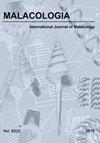石粒摄食对苹果螺小管果螺生长的影响
IF 0.7
4区 生物学
Q4 ZOOLOGY
引用次数: 7
摘要
摘要岩屑颗粒是淡水蜗牛消化道的常见特征。它们在消化过程中的作用已在一些微食和营养性物种中得到证实,因为它们促进生长、同化和繁殖。有人认为,它们可能在巨噬苹果螺(Pomacea canaliculata)中具有相同的功能,巨噬苹果螺具有强大的颌和齿,肌肉发达且角质化的砂囊和高水平的酶活性。本研究的目的是通过对自然种群canaliculata钉螺消化内容物的分析,了解钉螺消化道中石元素的存在情况,并通过室内实验研究石颗粒大小和有效性对钉螺生长和生长效率的影响。岩石颗粒在自然种群和实验室水族箱中的P. canaliculata的消化道中非常常见,如果它们在直接环境中可用的话。这些颗粒不会在胃中保留或集中,如果供应中断,它们显然会在不到四周的时间内完全消失。从口腔到肛门,植物物质和岩屑颗粒的频率增加,说明滞留时间也以同样的方式增加。沙子和植物物质经常同时出现在肠道和胃中,这表明两者是一起摄入的。地面大理石对小管松木的生长有不利影响,可能是由于这些颗粒的边缘和末端锋利。天然石粒(沙)的可用性对生长有积极影响,也与食物的可用性有协同作用。有砂时的生长效率比无砂时高25.2%。这些影响在雌性幼鱼中比雄性幼鱼中更为明显。我们的研究结果表明,在实验室条件下,如果没有定期提供锂离子颗粒,生长速度可能会被低估,并且它们的存在应该标准化,以便在研究之间进行可靠的比较。我们的研究结果还表明,食物供应和植物适口性对P. canaliculata生长的影响可能受到岩石颗粒存在的调节,这可能反过来影响苹果蜗牛、其他蜗牛和大型植物之间相互作用的结果。本文章由计算机程序翻译,如有差异,请以英文原文为准。
Effects of Ingestion of Lithic Particles on Growth of the Apple Snail Pomacea canaliculata (Caenogastropoda, Ampullariidae)
ABSTRACT Lithic particles are a common feature in the digestive tract of freshwater snails. Their role in the digestive processes has been demonstrated in some microphytophagous and detritivorous species, as they enhance growth, assimilation and reproduction. It has been suggested that they could have the same function in Pomacea canaliculata, a macrophytophagous apple snail with powerful jaws and radula, a strongly muscular and cuticularized gizzard and high levels of enzymatic activity. Our aims were to investigate the occurrence of lithic elements in the digestive tract of P. canaliculata snails from natural populations through the analyses of digestive contents, as well as the effect of size and availability of lithic particles on growth and growth efficiency through laboratory experiments. Lithic particles are very common in the digestive tract of P. canaliculata from natural populations and from laboratory aquaria if they are available in the immediate environment. Such particles are not retained or concentrated differentially in the stomach and they are apparently totally lost in less than four weeks if the supply is interrupted. The frequency of plant material and lithic particles increases from mouth to anus indicating that the retention time increases in the same way. Sand and plant material frequently co-occur in the intestine and in the stomach indicating that both are ingested together. Ground marble had negative effects on the growth of P. canaliculata probably due to the sharp edges and pointed ends of these particles. The availability of natural lithic particles (sand) had a positive effect on growth and also a synergic interaction with the availability of food. The growth efficiency was 25.2% higher when sand was available than when it was absent. These effects were more marked in juvenile females than in juvenile males. Our results indicate that growth rates may be underestimated under laboratory conditions if lithic particles are not supplied regularly and that their presence should be standardized to allow reliable comparisons between studies. Our results also indicate that the effects of food availability and plant palatability on the growth of P. canaliculata may be modulated by the presence of lithic particles and this may in turn affect the outcome of interactions between apple snails, other snails and macrophytes.
求助全文
通过发布文献求助,成功后即可免费获取论文全文。
去求助
来源期刊

Malacologia
生物-动物学
CiteScore
2.00
自引率
0.00%
发文量
15
审稿时长
3 months
期刊介绍:
Malacologia publishes papers on all groups of the Mollusca. Malacologia specializes in publishing long papers and monographic treatments. Complete data are especially appreciated. Papers must be of interest to an international readership. Papers in systematics, ecology, population ecology, genetics, molecular genetics, evolution and phylogenetic treatments are especially welcomed. Also welcomed are letters to the editor involving papers published or issues of import to science of the day.
 求助内容:
求助内容: 应助结果提醒方式:
应助结果提醒方式:


